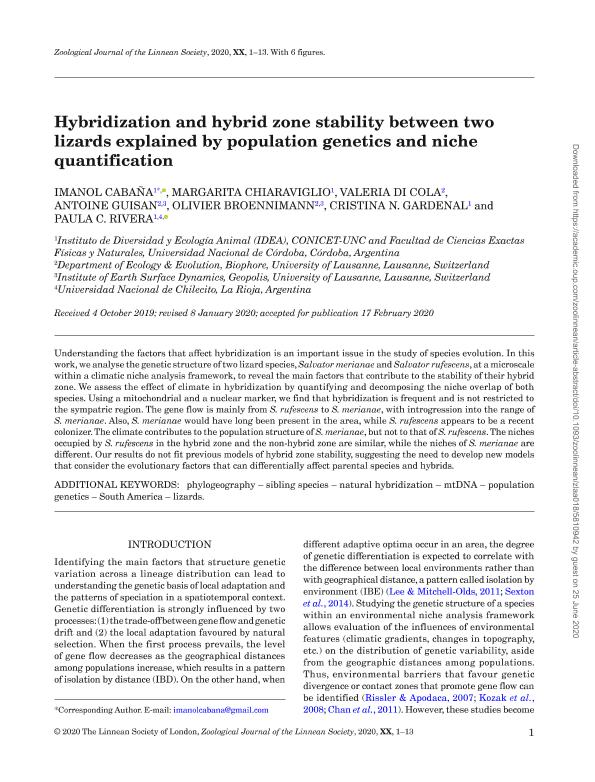Artículo
Hybridization and hybrid zone stability between two lizards explained by population genetics and niche quantification
Cabaña, Juan Imanol ; Chiaraviglio, Margarita; Di Cola Bucciarelli, Valeria
; Chiaraviglio, Margarita; Di Cola Bucciarelli, Valeria ; Guisan, Antoine; Broennimann, Olivier; Gardenal, Cristina Noemi
; Guisan, Antoine; Broennimann, Olivier; Gardenal, Cristina Noemi ; Rivera, Paula Cecilia
; Rivera, Paula Cecilia
 ; Chiaraviglio, Margarita; Di Cola Bucciarelli, Valeria
; Chiaraviglio, Margarita; Di Cola Bucciarelli, Valeria ; Guisan, Antoine; Broennimann, Olivier; Gardenal, Cristina Noemi
; Guisan, Antoine; Broennimann, Olivier; Gardenal, Cristina Noemi ; Rivera, Paula Cecilia
; Rivera, Paula Cecilia
Fecha de publicación:
21/10/2020
Editorial:
Wiley Blackwell Publishing, Inc
Revista:
Zoological Journal of the Linnean Society
ISSN:
0024-4082
e-ISSN:
1096-3642
Idioma:
Inglés
Tipo de recurso:
Artículo publicado
Clasificación temática:
Resumen
Understanding the factors that affect hybridization is an important issue in the study of species evolution. In this work, we analyse the genetic structure of two lizard species, Salvator merianae and Salvator rufescens, at a microscale within a climatic niche analysis framework, to reveal the main factors that contribute to the stability of their hybrid zone. We assess the effect of climate in hybridization by quantifying and decomposing the niche overlap of both species. Using a mitochondrial and a nuclear marker, we find that hybridization is frequent and is not restricted to the sympatric region. The gene flow is mainly from S. rufescens to S. merianae, with introgression into the range of S. merianae. Also, S. merianae would have long been present in the area, while S. rufescens appears to be a recent colonizer. The climate contributes to the population structure of S. merianae, but not to that of S. rufescens. The niches occupied by S. rufescens in the hybrid zone and the non-hybrid zone are similar, while the niches of S. merianae are different. Our results do not fit previous models of hybrid zone stability, suggesting the need to develop new models that consider the evolutionary factors that can differentially affect parental species and hybrids.
Archivos asociados
Licencia
Identificadores
Colecciones
Articulos(IDEA)
Articulos de INSTITUTO DE DIVERSIDAD Y ECOLOGIA ANIMAL
Articulos de INSTITUTO DE DIVERSIDAD Y ECOLOGIA ANIMAL
Citación
Cabaña, Juan Imanol; Chiaraviglio, Margarita; Di Cola Bucciarelli, Valeria; Guisan, Antoine; Broennimann, Olivier; et al.; Hybridization and hybrid zone stability between two lizards explained by population genetics and niche quantification; Wiley Blackwell Publishing, Inc; Zoological Journal of the Linnean Society; 190; 2; 21-10-2020; 757-769
Compartir
Altmétricas



